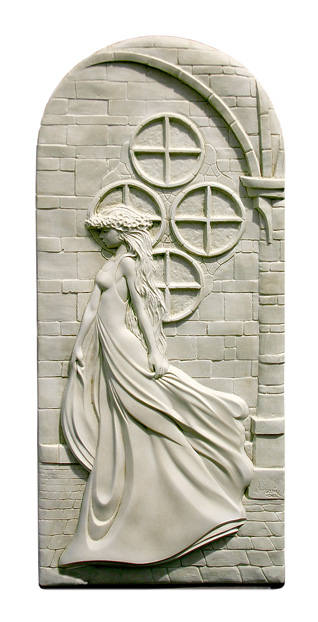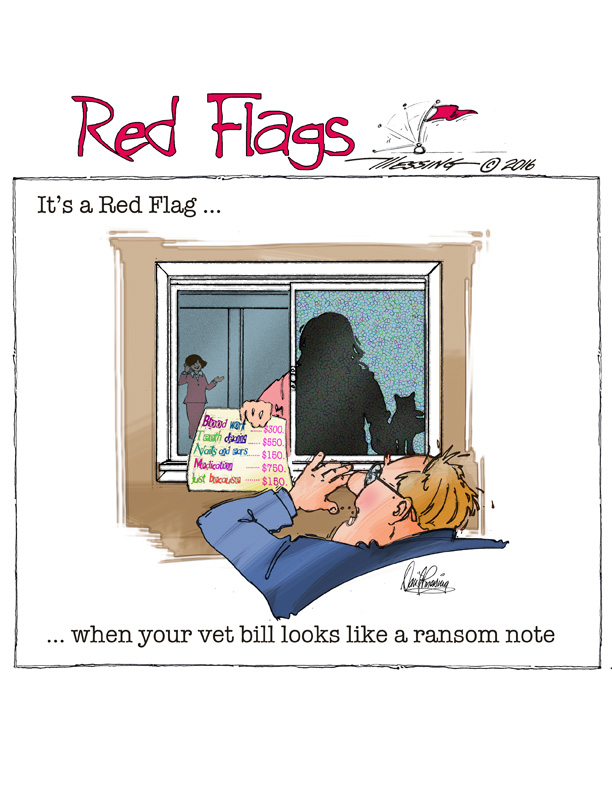ARTISTIC OOPS-IES !
Perhaps it’s because I’m a “seasoned” artist (an old guy with a nearly all white beard and wispy hair) that I am often asked to speak at art clubs and jury art shows. I could and probably should write a book on some of the “artistic oops-ies” I have observed over the years.
While jurying, I once noticed a well-drawn row of beautiful Can-can dancing girls. The work was rather commercial, yet so well executed that I loved it right off. On my second or third go-around, I began to notice that something was wrong. There were six beautiful female heads, six clouds of ruffled flowing dresses, yet only five female fannies and five sets of legs. Just like the oft-painted bouquet of flowers in still life paintings, I always count the flower blossoms to ensure there are an equal number of stems to support them. Not that I haven’t made similar mistakes …
On my first cartoon commissioned for an international magazine, I was asked to draw a big crowd of protestors. Filled with excitement (and some delusions of grandeur), I drew all the funny and diverse people in the front row and carefully inked all their little outfits and tiny signs. Next, I drew a hundred (or so it seemed) heads and shoulders and signs of all the protestors behind them as well as in the distance of the background. So excited, I proudly signed it, mailed it, and couldn’t wait to see my first printed cartoon in an international magazine. When it finally came in the mail, I quickly fanned the magazine to locate the article featuring my cartoon. To my instantaneous horror, I noticed there were no legs or feet of anyone in the crowd behind the first row of protestors! Zero! Nada! None! I had left them all out of my drawing!
Now, let’s revisit the mistakes I have witnessed by others … I have seen perspective problems that would make M.C. Escher get a bad case of vertigo and lose his lunch. I have spied water scenes and shorelines that are not level, country roads that get wider in the distance, trees that taper in reverse, scale that defies logic, just to name a few of the many artistic oops-ies that have grabbed my attention throughout my career. Then, there are the usual anatomical miss-steps that can boggle the mind, such as thumbs drawn on the wrong side of the hand, too many fingers, or missing pinkies. Some of my favorites are Quasimodo eyes and alien proportions. I use the phrase “boggle the mind” not because I have not made similar errors, but because these kinds of works of art managed to make it through the finishing stages, get matted and framed, and then were selected by the artist for entry into the jurying process. How did everyone not see that there were four knuckles on one finger?
 And then there is me. I love the whole medieval-maiden look and wanted to do a bas-relief of a beautiful young maiden walking briskly with her gown flowing. In the finishing stages, I was high-fiving myself as it was turning out exactly as I had envisioned. While smoothing out the clay on my final pass, I stopped to admire the many curves, folds and anatomy details (we all know hands are usually a bit of a problem). This particular piece featured one very feminine hand with six beautifully tapering fingers! Say What? How in the world? Huh? At least I caught it before anyone saw it.
And then there is me. I love the whole medieval-maiden look and wanted to do a bas-relief of a beautiful young maiden walking briskly with her gown flowing. In the finishing stages, I was high-fiving myself as it was turning out exactly as I had envisioned. While smoothing out the clay on my final pass, I stopped to admire the many curves, folds and anatomy details (we all know hands are usually a bit of a problem). This particular piece featured one very feminine hand with six beautifully tapering fingers! Say What? How in the world? Huh? At least I caught it before anyone saw it.
In one show I had already done the jury selection and there was a waiting period before I would award the ribbons and placement honors. The artworks that I had chosen for display were so exceptional that I decided to take my adult art class to the show and point out some of things I look for when jurying art. Droning on about color, texture, perspective and balance, I paraded my little band of students around the show. While praising the many fine features of this particular waters edge scenic painting, one of the meekest of my students raised her hand and asked, “why is there a tree reflecting in the water when there is no tree on the shore line?” All I could do is blush and laugh at myself for not noticing.
As artists, the excuse for our often funny, artistic oops-ies is that we take an inspired idea and make the Herculean attempt to bring it from the mental-spiritual realm and present it in this “here and now” physical dimension. We start with a blank piece of paper, a gessoed canvas, a mounted piece of watercolor paper, a lump of clay, a chunk of wood, or maybe a stone megalith. In this third dimensional transition, we are often somewhat blind to our own creation. We got it this far, yet we often do not see our own missteps, mistakes, or omissions. In the production of the whole piece, it is way too easy to misrepresent or omit a particular detail. How unfair that one of those little details can cancel the value of the whole art production! In my Maiden bas-relief, that sixth finger had no impact on the entire piece and, in fact, was hardly noticeable… But, wow! Am I so glad that I noticed it! As a matter of fact, at one time, I had her slippered feet pointing out from under her gown. Fortunately, I asked Bob Perrish, my very talented artist-friend, to critique my maiden before I made the mold, and in seconds, he said, “get rid of her feet; it’s messing up the scale of the piece”… and he was completely correct!
EVERYONE needs an honest critique! And the evaluation rating scale looks something like this:
1. The average guy off the street = OK
2. A friend or family member = Good
3. Other artists, peers, or masters = A treasured event and often a reputation saver.
Find your Artistic Oops-ies … and fix’em !




